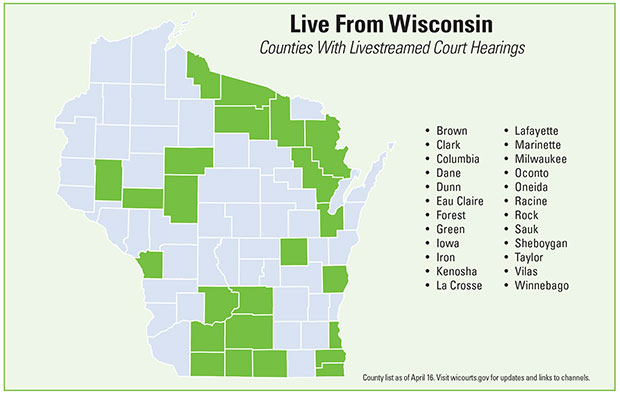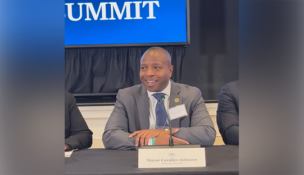State courts adapt to Zoom online videoconferencing proceedings
By: Michaela Paukner, [email protected]//April 23, 2020//
State courts adapt to Zoom online videoconferencing proceedings
By: Michaela Paukner, [email protected]//April 23, 2020//

“We’ll call the treatment court session into order. This is April 15, 2020, so welcome everyone.”
From a transcript, Dunn County Circuit Court Judge James Peterson’s April 15 treatment court session would seem to be business as usual. But for the participants, the setting wasn’t quite the same.
On a recent day, Peterson met with various parties using Zoom online videoconferencing, which was then livestreamed on Branch 1’s YouTube channel for the public. Peterson was the only one who was physically present at the courthouse in Menomonie, northwest of Eau Claire. The other six participants either joined from their individual homes or, in one case, a car.
Dunn County Branch 1 is one of about 70 circuit court branches in 23 counties livestreaming court proceedings during the COVID-19 pandemic. After Gov. Tony Evers declared a public health emergency on March 12, the Wisconsin Supreme Court temporarily suspended jury trials and in-person appearances, allowing very few exceptions.
Around the time of the emergency declaration, Director of State Courts Randy Koschnick said the court system had purchased a license for Zoom and issued Zoom accounts to the state’s 249 circuit court branches. Already he was anxious that courtrooms might be shut down because of the pandemic and wanted to find alternative ways to keep them open.
“Zoom gives judges the tools to get their dockets running again while respecting social distancing and other rules that have been announced by the governor,” Koschnick said. “We’re trying to provide more transparency and access to the public using technology.”
Peterson, who hadn’t heard of Zoom before the court’s adoption of it, said openness and transparency are why he’s committed to making use of the new technology and why he’s encouraging others to turn to it as well.
“If you’re doing the public’s work, although it makes some people a little nervous and uncomfortable to have a camera on you all the time, it’s pretty important to be open,” Peterson said.
Using Zoom as the courtroom
Koschnick and his team — including Jean Bousquet, CCAP chief information officer — have been the ones chiefly responsible for getting Zoom to work with new and existing court technology, including courtroom video-conference systems and YouTube.

YouTube provides public access to court proceedings, while helping to keep them secure. Courts have been holding closed Zoom meetings, which are open only to participants who have received an email invitation, and then streaming the proceedings live on YouTube. Koschnick said this system eliminates opportunities for “Zoombombing” — unwanted meeting interference from hackers.
“We follow a pretty strict regimen of security measures to make sure we don’t have interference,” Koschnick said. “By streaming it out through the YouTube channel, we still provide public access, and at the same time, we greatly reduce the possibility of interference by unwanted parties.”
In Wisconsin, all judges have the ability to use Zoom for court proceedings and each can make an individual decision whether to do so. Koschnick said the idea has been accepted quickly. In general, it has been judges who are most comfortable with technology who have been the quickest to start.
Among the earliest adopters have been Kenosha County Circuit Court Judge Jason Rossell and Marinette County Circuit Court Judge James Morrison. The two have even established protocols that have been shared statewide to help others get used to the new technology.
“Most judges are really experimenting with the new tools and doing so successfully,” Koschnick said. “Some are waiting to see how it plays out to fully utilize it. It’s going to take some time to get worked out and widely accepted and utilized.”
The Wisconsin Supreme Court has joined the growing list of state courts adopting Zoom. The high court scheduled nine cases for oral arguments using Zoom, starting on April 20.
During the first case of the day, Nancy Bartlett v. Tony Evers, each person speaking was shown on the full screen of a live video broadcast on WisconsinEye. Camera images switched on and off as justices asked questions and attorneys answered.
Chief Justice Pat Roggensack served as a moderator of sorts, telling lawyers when they were nearing their time limits and keeping the proceedings moving. “I think this worked fairly well from our perspective on this side of the bench,” Roggensack said in the end.
Going through the motions
Mike Wittenwyler, a Godfrey & Kahn shareholder and lead attorney in the firm’s Political Law Group, was among the litigators who used Zoom to argue a case before the state Supreme Court that day. While preparing for the appearance, he and his partner tried to foresee how using video to present arguments would differ from doing so in person.
“Basically, you’re going to be texting each other through the argument,” Wittenwyler said. “We’re not sitting at the counsel table together.”
Wittenwyler said court proceedings flow differently when they’re done on video. Even before his Zoom appearance before the Supreme Court, he had taken part in a motion hearing in Milwaukee County Circuit Court.
“It was much more structured via Zoom,” Wittenwyler said. “The judge would act like a moderator, and everybody went when the judge called on you. It wasn’t as free-flowing as in a courtroom.”
Milwaukee County Circuit Court Judge Timothy Witkowiak served as moderator in that motion hearing, which was one of about 10 Zoom proceedings he’d held since adopting the technology.
“I was surprised at how well it worked out,” Witkowiak said. “In these times, I think it’s our best alternative.”
Witkowiak said he noticed fairly quickly that joining meetings from his computer, rather than his phone, allowed him to see parties’ responses better.
“It’s been very efficient for me to be able to get through hearings that I couldn’t if we were to do simple phone hearings,” Witkowiak said. “I think it would be much more difficult to focus on issues to the extent that you can when you have the video presentation.”
Peterson said he prefers Zoom to phone hearings as well. He’s been using Zoom for Dunn County’s intake court, which hears about 200 hearings on average each week, along with treatment court and other proceedings.
Dunn County restructured its intake court to break up meetings into sessions lasting between 15 and 20 minutes to help manage the number of people involved at any given time. Peterson said people are still primarily calling in by phone, which can muddle the proceedings.
“You’re not overwhelmed with everybody at once, but it’s not uncommon to have five phone numbers and you don’t know who is who,” Peterson said. “That’s a little chaotic. And if you can’t see people and they can’t see you, it makes it a little bit different to explain things.”
Digital difficulties
For Peterson and courts in District X, which encompasses northwestern Wisconsin, a big stumbling block for parties scheduled to make appearances remains a lack of access to devices and the Internet.
“Many of the people we deal with are financially challenged,” Peterson said. “People are running out of minutes on their phone, particularly treatment court participants. Our treatment court lasts for about an hour, and if they stay on the whole time, and they have to pay for their minutes, there’s an hour of their minutes that are used up.”
He said most of the people who have appeared before him have been able to find a way to call in or a device to share, but he said a smartphone is a luxury many take for granted.
When it comes to attorneys, Peterson said he has a hard time convincing them to use videoconferencing, rather than call in by phone. He’s been asking lawyers who want to appear by phone to try Zoom, and most have been open to the idea.
“The more you do it, the more comfortable you become,” Peterson said. “It sure beats the alternative. I just can’t imagine, if everything starts backing up, how we’d ever dig out.”
Witkowiak said his Zoom court proceedings primarily involve lawyers, many of whom agree that using videoconferencing is better than having a case backlog.
“In speaking off the record after the meeting, I think the attorneys are pleased that we’re at least able to move forward on these things,” Witkowiak said.
Zoom best practices
As judges are getting proceedings back up to speed with Zoom, Koschnick said he is encouraging attorneys to help the courts avoid future gridlock.
“If you’ve had cases that have been canceled, or you’ve been waiting to file a case, please think about getting those back on the calendar within the next few weeks, rather than the next several months,” Koschnick said.
Koschnick has also recommended that attorneys do a test-run meeting with another person to check their bandwidth and connections. Weak WiFi signals can cause choppy video and audio, which will disrupt proceedings. A test run will help identify any causes for concern before proceedings start.
For people appearing from home, it’s also important to have appropriate backgrounds and dress. A Florida judge recently scolded one attorney for appearing shirtless and another for joining a meeting while still in bed.
“Remember that you’re still appearing in court, so it’s important to have an appropriate background and to dress appropriately,” Koschnick said. “We want to keep it a dignified proceeding, even though we’re using video technology.”
Looking ahead
Despite being open to the recent changes, many are still looking ahead to when the courts can return to their usual, in-person operations. Witkowiak said he hasn’t so far had to move an unduly large number of proceedings, but without anyone knowing how long the pandemic will last, it’s hard for him to say how his calendar will be affected.
“You hate to delay evidentiary hearings to the extent that the calendar becomes overburdened,” Witkowiak said. “So far we’re OK, but we have had to move those jury trials from March to June 15.
That does raise some concerns about the quantity we’re going to have when we get back.”
Peterson also has been thinking how jury trials will proceed once the state begins to open back up.
“Even if it’s in June or July or next fall, a lot of people may be terrified about having to come in and be on jury duty,” Peterson said. “It’s a very real concern, and I think we’re going to have to come up with some way to use technology to be able to do this.”
Peterson is curious to see what technology and changes will stay around even after people are allowed to start coming together for in-person meetings again. Wittenwyler, for his part, hopes proceedings return to the pre-pandemic normal.
“My preference for doing everything is always in person,” Wittenwyler said. “To me, it’s very important to show up, and I would hope this doesn’t become the norm — it just becomes an exception during the pandemic.”
Legal News
- Giuliani, Meadows among 18 indicted in Arizona fake electors case
- Some State Bar diversity participants walk away from program
- Wisconsin court issues arrest warrant ‘in error’ for Minocqua Brewing owner
- Iranian nationals charged cyber campaign targeting U.S. Companies
- Facing mostly white juries, are Milwaukee County defendants of color truly judged by their peers?
- Milwaukee Mayor speaks in D.C. Tuesday at White House water summit
- Chicago man sentenced to prison after being caught with ‘Trump Gun’
- FTC bans non-competes
- Gov. Evers seeks applicants for Dane County Circuit Court
- Milwaukee man charged in dismemberment death pleads not guilty
- Democratic-led states lead ban on the book ban
- UW Madison Professor: America’s child care crisis is holding back moms without college degrees
WLJ People
- Power 30 Personal Injury Attorneys – Russell Nicolet
- Power 30 Personal Injury Attorneys – Benjamin Nicolet
- Power 30 Personal Injury Attorneys – Dustin T. Woehl
- Power 30 Personal Injury Attorneys – Katherine Metzger
- Power 30 Personal Injury Attorneys – Joseph Ryan
- Power 30 Personal Injury Attorneys – James M. Ryan
- Power 30 Personal Injury Attorneys – Dana Wachs
- Power 30 Personal Injury Attorneys – Mark L. Thomsen
- Power 30 Personal Injury Attorneys – Matthew Lein
- Power 30 Personal Injury Attorneys – Jeffrey A. Pitman
- Power 30 Personal Injury Attorneys – William Pemberton
- Power 30 Personal Injury Attorneys – Howard S. Sicula











